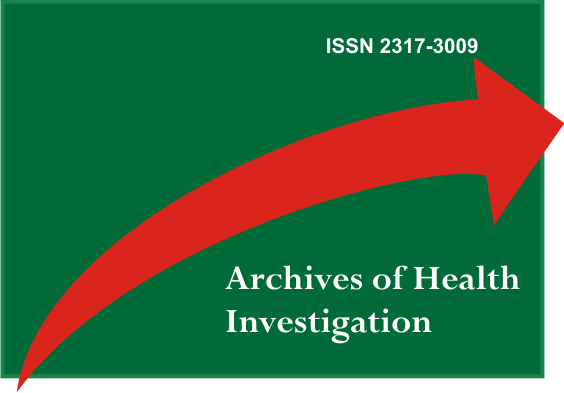Microrganismos oportunistas na boca de pacientes irradiados: avaliação de 12 meses pós-tratamento
Resumo
O presente estudo avaliou a ocorrência de microrganismos oportunistas da família Enterobacteriaceae e dos gêneros Enterococcus e Staphylococcusna microbiota bucal de pacientes oncológicos submetidos a radioterapia de cabeça e pescoço. Inicialmente, 50 pacientes foram avaliados imediatamente antes do tratamento radioterápico, 15-22 dias após o início do tratamento, imediatamente após o final da radioterapia, 30 dias após o tratamento, 6 e 12 meses após a conclusão da terapia, quando também realizava-se a coleta de biofilme, mucosas e saliva para avaliação microbiológica. Para a última avaliação, 12 meses após a radioterapia, apenas 28 pacientes puderam ser contatados e avaliados e 15 forneceram espécimes clínicos para avaliação microbiológica. A ocorrência dos patógenos oportunistas foi determinada por amplificação do ácido desoxirribonucleico pela reação em cadeia da polimerase utilizando-se de iniciadores e condições específicas para cada microrganismo. Os dados foram submetidos aos testes de Qui-quadrado, Mann-Whitney e exato de Fisher. As diferenças na distribuição dos diferentes microrganismos foram avaliadas através de análise de variância de medidas repetidas para dados categóricos. Os pacientes irradiados desenvolvem severa mucosite, dermatite, disfagia, disgeusia, xerostomia e, em menor extensão, candidose. Observou-se um aumento significativo na prevalência dos microrganismos estudados, destacando-se os microrganismos entéricos. Os resultados sugeriram que a colonização bucal por microrganismos oportunistas foi frequente e estável ao longo do tempo, mas sem uma nítida correlação com a saúde bucal e intensidade do tratamento radioterápico.Descritores: Radioterapia; Neoplasias de Cabeça e Pescoço; Infecções Oportunistas.
Downloads
Referências
Bhide SA, Newbold KL, Harrington KJ, Nutting CM. Clinical evaluation of intensity-modulated radiotherapy for head and neck cancers. Brit J Radiol. 2012;85:487-94.
Randall K, Stevens J, Yepes JF, Randall ME, Kudrimoti M, Feddock J, et al. Analysis of factors influencing the development of xerostomia during intensity-modulated radiotherapy. Oral Surg Oral Med Oral Pathol Oral Radiol. 2013;115:772-9.
Pinna R, Campus G, Cumbo E, Mura I, Milia E. Xerostomia induced by radiotherapy: an overview of the physiopathology, clinical evidence, and management of the oral damage. Ther Clin Risk Manag. 2015;11:171-88.
Paterson C, Caldwell B, Porteous S, Mclean A, Messow CM, Thomson M. Radiotherapy-induced xerostomia, pre-clinical promise of LMS-611. Support Care Cancer 2015. Doi 10.1007/s00520-015-2823-5.
Lalla RV, Saunders DP, Peterson DE. Chemotherapy or radiation-induced oral mucositis. Dent Clin N Am 2014;58:341-9.
Jham BC, França EC, Oliveira RR, Santos VR, Kowalski LP, Freire ARS. Candida oral colonization and infection in Brazilian patients undergoing head and neck radiotherapy: a pilot study. Oral Surg Oral Med. Oral Pathol Oral Radiol Endod. 2007; 03:355-8.
Barasch A, Peterson DE. Risk factors for ulcerative oral mucositis in cancer patients: unanswered questions. Oral Oncol. 2003;39:91-100.
Al-Dasooqi N, Sonis ST, Bowen JM, Bateman E, Blijlevens N, Gibson RJ, et al. Emerging evidence on the pathobiology of mucositis. Support Care Cancer 2013;21:2075-83.
Leung WK, Jin LJ, Yam WC, Samaranayake LP. Oral colonization of aerobic and facultative anaerobic Gram-negative rods and cocci in irradiated, dentate, xerostomic individuals. Oral Microbiol Immunol. 2001;16:1-9.
Gaetti-Jardim Jr E, Ciesielski FIN, Sousa FRN, Nwaokorie F, Schweitzer CM, Avila-Campos MJ. Occurrence of yeasts, pseudomonads and enteric bacteria in the oral cavity of patients undergoing head and neck radiotherapy. Braz J Microbiol. 2011;42:1047-55.
Vanhoecke B, De Ryck T, Stringer A, Van de Wiele T, Keefe D. Microbiota and their role in the pathogenesis of oral mucositis. Oral Dis. 2015;21:17-30.
Sampaio EF, César FN, Martins MGA. Perfil odontológico dos pacientes portadores de necessidades especiais atendidos no Instituto de previdência do estado do Ceará. RBPS 2004;17:127-34.
Gaetti-Jardim Jr E, Fardin AC, Gaetti-Jardim EC, Castro A. L.; Schweitzer, C. M. Microbiota associated with chronic osteomyelitis of the jaws. Braz J Microbiol. 2010;41:1056-64.
Brunner E, Langer F. Nonparametric analysis of ordered categorical data in designs with longitudinal observations and small sample sizes. Biomet J. 2000;42:663-75.
Al-Nawas B, Grotz KA. Prospective study of the long change of the oral flora after radiation therapy. Support Care Cancer 2006;14:291-6.
Rubira CMF, Devides NJ, Ùbeda LT, Bortolucci Jr AG, Lauris JR, Rubira-Bullen IR, et al. Evaluation of some oral postradiotherapy sequelae in patients treated for head and neck tumors. Braz Oral Res. 2007;21:272-7.
Chambers MS, Garden AS, Kies MS, Martin JW. Radiation-induced xerostomia in patients with head and neck cancer: pathogenesis, impact on quality of life, and management. Head Neck Surg. 2004;26:796-807.
Sennhenn-Kirchner S, Freund F, Grundmann S, Martin A, Borg-von Zepelin M, Christiansen H, et al. Dental therapy before and after radiotherapy - an evaluation on patients with head and neck malignancies. Clin Oral Invest. 2009;13:157-64.
Almståhl A, Wikström M, Fagerberg-Mohlin B. Microflora in oral ecosystems and salivary secretion rates - A 3-year follow-up after radiation therapy to the head and neck region. Arch Oral Biol. 2015;60:1187-95.
Gonçalves MO, Coutinho-Filho WP, Pimenta FP, Pereira GA, Pereira JAA, Mattos-Guaraldi AL, et al. Periodontal disease as reservoir for multi-resistant and hydrolytic enterobacterial species. Lett Appl Microbiol. 2007;44:488-94.
Slots J, Rams TE, Feik D, Taveras HD, Gillespie GM. Subgingival microflora of advanced periodontitis in the Dominican Republic. J Periodontol. 1991;62:543-7.
Almståhl A, Wikström M, Groenink J. Lactoferrin, amylase and mucin MUCB and their relation to the oral microflora in hyposalivation of different origins. Oral Microbiol Immunol. 2001;16:345-52.
Ramirez-Amador V, Silverman Jr S, Mayer P, Tyler M, Quivey J. Candidal colonization and oral candidiasis in patients undergoing oral and pharyngeal radiation therapy. Oral Surg Oral Med Oral Pathol Oral Radiol Endod. 1997;84:49-53.
Vidal-Casariego A, Fernández-Natal I, Calleja-Fernández A, Parras-Padilla T, Cano-Rodríguez I, Prieto-Alonso B, et al. Nutritional, microbiological, and therapeutic factors related to mucositis in head and neck cancer patients: a cohort study. Nutr Hosp. 2015;32:1208-13.
Sonis ST. Mucositis: the impact, biology and therapeutic opportunities of oral mucositis. Oral Oncol. 2009;45:1015-20.
Kubota K, Kobayashi W, Sakaki H, Nakagawa H, Kon T, Mimura M, et al. Professional oral health care reduces oral mucositis pain in patients treated by superselective intra-arterial chemotherapy concurrent with radiotherapy for oral cancer. Support Care Cancer 2015;23:3323-9.
Nagy KN, Sonkodi I, Szöke I, Nagy E, Newman HN. The microflora associated with human oral carcinomas. Oral Oncol. 1998;34:304-8.


